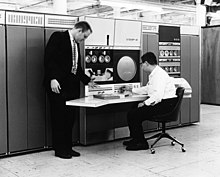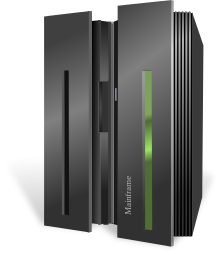Introduction to Computer Information Systems/Computers to Fit Every Need
Phablets
[edit | edit source]Phablets, a portmanteau of "Phone" and "Tablet", were first pioneered in 2007 by HTC. The concept was an original hybridization, borrowing the large, touchscreen display from a tablet computer and the functionality and size from a mobile cellular phone. The idea was eventually adopted by other large manufacturers including LG (GW990) and Nokia (N810), and underwent several different phases. The early generations had, in addition to a touchscreen, physical keyboards whereas the later ones do not. The Verizon Streak, produced and carried by the network, was released in 2009. Unlike most others at the time, it was restricted to phone and internet use within the household only. The current style of phablets was not popularized until 2011, after the launch of the Samsung Galaxy Note, (Android) which featured a 5.3" inch display and a removable stylus.[1]

Embedded Computers
[edit | edit source]

An embedded computer is a mini computer with a specific function within a product that completes detailed tasks or jobs for that product. Often times, individuals do not realize how many objects have embedded computers enclosed in them. Some examples of embedded computers used in households include, remote controls, heating pads, digital clocks, washing machines, and microwaves. Others include Bluetooth capabilities in cars, camera traffic lights, and Red Box machines. Surprisingly, a pregnancy test is also considered a simple, yet complicated embedded computer.[2] Embedded computers are developed to do one particular duty, and therefore a regular computer cannot act as an embedded computer.
So how does an embedded computer work? To put it into simple terms, an embedded computer is a computing chip rooted directly onto its motherboard or logic board. Before embedded computers were invented, a computing chip would be connected via wires to the motherboard, which would then be connected via more wires to the RAM and other peripherals. This not only made the interior of any computing device look like an absolute mess, but it was incredibly inefficient and performance was never what it could have been given the capacities of the components involved. With the advent of “embedded” or “integrated” components, the interior is free of all these transferring wires, and data only needs to bridge a small gap, rather than travel through tons of cables. The advantages of the embedded computers are that the bussing speed for data has greatly improved over externally transported components due to the minimal amount of physical distance data needs to travel.[3] Today, there are specialized jobs just for programming embedded computers.[4] The first embedded system used was the Apollo Guidance Computer created by Charles Stark Draper. It was considered to be one of the highest risks in the Apollo project since it was newly developed, but since then it has been proven to be more efficient.[5] Embedding computer technology has continued to develop and the “gaps” that needed to be covered have become smaller and smaller. A great example of this is the cell phone, which has evolved from the first “portable” bag phones into today’s iPhone5s that can fit in the palm of one’s hand. These embedded computer systems are used in all areas of life, and can be found anywhere from cooking and consumer functions to medical and military tasks.[6]
Mobile Devices
[edit | edit source]A mobile device is a handheld tablet or other device that is made for portability, and is therefore both compact and lightweight. New data storage, processing and display technologies have allowed these small devices to do nearly anything that had previously been traditionally done with larger personal computers.[7] These mobile devices are capable of numerous tasks including making phone calls, sending text messages, viewing Web pages, playing games, downloading music, taking digital photos, and watching TV shows and movies. With our ever-growing world of technology, mobile devices are at the tips of our fingers. Questions can be answered, maps can be observed, and weather can be checked. Of the many mobile devices used today, smartphones are the most common form of device. They have Internet capabilities along with the extensive list above. Tablet devices do not have all the capabilities smartphones have, but they are used for Web browsing, gaming, taking digital photos, and playing movies as well as TV shows. Mobile devices are now a big part of people’s everyday lives. Google stated, “The mobile phone might be the world’s most ubiquitous device…” (www.thinkwithgoogle.com/insights/uploads/940910.pdf/download/). This shows how technology will keep improving, to become the some of the most widely used devices around.
One of the drawbacks to some of the newer mobile devices is their use of non removable batteries. These batteries are designed to make the device more light weight. Although they are made to last for the duration of the computers life, there are instances when they fail. If this happens, it can be pricy and difficult for them to be replaced. Because of this, it is not uncommon for a user to simply throw the device away rather than spend the time or money to fix it. This has resulted in a big increase in what is known as e-trash, or electronic trash. Adding to this problem is the fact that these devices often contain toxic and harmful chemicals and eventually end up in landfills that are not able to dispose of them properly. Much of these devices make their way to countries with less standards and regulations for waste management, giving way to environmentally unfriendly and dangerous practices. This leads to toxic and lethal chemicals entering the air and water. Certain organizations such as Clean Production Action and Greenpeace have developed programs to attempt to persuade manufactures to stop using hazardous chemicals in their products. Unfortunately it may already be too late to reverse the damages done from e-waste. It is essential for the well being of this planet that mobile devices and other computer equipment are disposed of properly.[8]
Personal Computers
[edit | edit source]
A personal computer is a computer that is mainly for individual use. Before personal computers, computers were designed for companies who would then attach terminals that would allow for more than one user to a single large computer and the resources were shared among all users. The first personal computers came out around the 1970s. The most popular of the time was the Apple II, which came out in 1977 from Apple Computer. In 1981, IBM came out with its first personal computer. IBM PC took over the market and it was what most people bought. Personal computers use single-user systems and are based on microprocessors.[9] Many people do link their personal computers together to create a network. Most personal computers are made up of a central processing unit, control circuitry on an integrated circuit, and various input/output devices. It also contains two types of memory; main memory and auxiliary memory. The sales of personal computers has grown tremendously over the years, according to Michael Dell in 2005 there were 240 million personal computers sold worldwide.[10] The sale of personal computers will, likely, continue to increase.
Midrange Servers
[edit | edit source]

Midrange servers were also known as midrange computers or minicomputers in 1960s and were mostly sold to small and medium-sized businesses. However, midrange servers started to become popular in the 1990s. Midrange servers are used to host data and programs for networks, such as in hospitals or school computer labs. Midrange servers stand in between entry-level servers and mainframe computers. The big difference between midrange servers and mainframe computers is that the midrange servers function as stand-alone personal computers where mainframes are a network hosts. Midrange servers tend to have more memory capacity, such as random access memory (RAM), processing power (have multiple processors), room for expansion (have comparably large hard drives), and are more expensive than desktop computers.[11] Midrange servers are not limited for business use only. Another type of midrange servers is a special home server that can be build or purchase when personal computer is not enough. Special home server links all the content from all the computers onto one network.[12] Moreover, something that is happening more frequently with midrange servers is called virtualization. It involves splitting hard drives and creating two separate hard drives. It can also involve server virtualization which is splitting the physical server into smaller virtual servers. Each virtual server can run multiple operating system requests at the same time. Virtualizing servers is the best solution for small and medium-scale applications.[13] Virtualization helps companies to use fewer servers and that leads them to reduced costs and less server management.[14]
Mainframe Computers
[edit | edit source]

Mainframe Computers are much larger computers that consolidate the needs of large organizations like universities, hospitals, banks, government offices, etc. These much more powerful and expensive computers are usually stored in data centers where they connect to all the other computers using a computer network. From this room a single mainframe can serve thousands of users on the same network. Early mainframe computers were first produced in the 1950s due to the increasing processing demands of growing businesses. From then on, these mainframes have increased in power and improved in size.[15] However, with more processing power, this requires more energy consumption, leading computer manufacturers to focus more on energy efficiency in these new computers. Manufacturers also began bundling free software with their mainframe computers as an incentive to help compete against other computer manufacturers. Eventually, a lot of these programs and several new ones were offered as separate products that they could sell rather than just giving them away for free.[16] Today, mainframe manufacturers use advances in technology to further improve the power and efficiency of their computers, one important being virtualization, creating several virtual servers rather than physical ones that take up space.
Mainframe computers may be good for having one space to collect data for a company. They are also known as high end servers, or enterprise class servers. The mainframe computer at IBM has 100,000 virtual servers and is actually very economically efficient, and more and more of businesses are trying to make them the most energy efficient as possible. The mainframe computers need a large enough space to be located for one, since they are used for large business responsibilities, such as computing data for a census, statistics, and economic processing. They are also used for payroll and billing but are constantly running day and night with different tasks to complete all the time. The type of tasks this computer does allow for them to operate for a long time with no interruptions. Mainframe computers are also very expensive. Having to find a way to cool a mainframe computer is difficult just because of their size alone. The other problem with the computers is that they are also expensive to even run, again because of their size. The amount of electricity to cool and run the mainframe computers makes them not the most energy efficient machine to have in a business.
References
[edit | edit source]- ↑ http://www.verizonwireless.com/mobile-living/tech-smarts/what-is-a-phablet-verizon-samsung/
- ↑ http://www.pcmag.com/article2/0,2817,2379383,00.asp
- ↑ Understanding Computer Today and Tomorrow 14th Edition Comprehensive
- ↑ http://searchenterpriselinux.techtarget.com/definition/embedded-system
- ↑ https://en.wikipedia.org/wiki/Embedded_system
- ↑ https://en.wikipedia.org/wiki/Embedded_system
- ↑ http://www.techopedia.com/definition/23586/mobile-device
- ↑ Understanding Computer Today and Tomorrow 14th Edition Comprehensive
- ↑ http://www.webopedia.com/TERM/P/personal_computer.html
- ↑ http://whatis.techtarget.com/definition/personal-computer-PC
- ↑ http://www.wisegeek.com/what-is-a-midrange-computer.htm
- ↑ http://www.techopedia.com/definition/14471/midrange
- ↑ http://www.techopedia.com/definition/719/virtualization
- ↑ http://searchservervirtualization.techtarget.com/definition/virtualization
- ↑ http://www.computerhistory.org/revolution/mainframe-computers/7/172
- ↑ http://www.computerhistory.org/revolution/mainframe-computers/7/172
